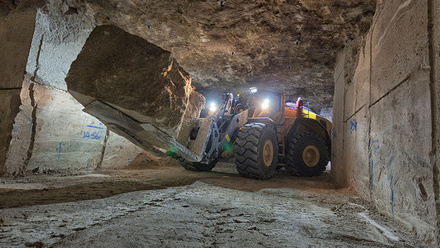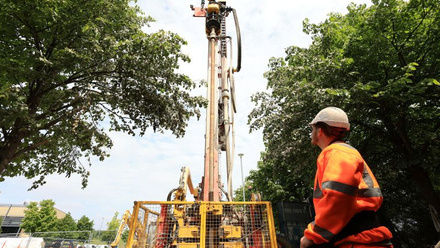Mining health and safety
Professional development in health and safety for the mining sector.

In August, I will have worked in the mining industry for 50 years, having started out as an Apprentice Electrician, and I am more passionate now than ever about giving something back.
My journey has seen me become President of the Midlands Institute of Mining Engineers (MIMinE) in 2005-6, and I am the immediate past President of the Association of British Mining Expertise (ABMEC) 2024. My motivation is to extend and leverage my network to drive collaboration among mining sector stakeholders.
This endeavour includes establishing a Mining Competence Community (MCC) – to share best practice, knowledge and competence development methodologies.
While the community provides consultancy to a range of UK and international clients, it also offers a free mentoring solution to young engineers to pass on a generation of industry knowledge and practical experience, so we don’t lose what we have learned for more than a century of safe, modern and mechanised underground mining in public and private sectors.
The MCC team members have all held executive, senior management and statutory operational positions at a range of mines extracting different minerals.
The team maintains currency of competence through membership of the MIMinE, by ongoing continuous professional development, active work in the sector, and through close connections with ABMEC and the Mining Industry Leadership Group (MILG) initiatives. These include the UK Mining Central Engineering Forum, the UK Mining Education Forum, the Mining Qualifications Committee and Safe Man Riding in Mines Committee.
These are industry-wide forums for sharing best practice, current engineering trends, modern technology, experience and learnings from incidents. The aim is to deliver on the MILG strategic goals of leadership, involving the workforce, avoiding catastrophe, building competence and creating healthier safer workplaces.
One example is a working group to drive safe use of lithium-ion battery technology in all mining applications.
We deliver on the MILG goals primarily by focusing on four key areas.
Mentoring
The MCC comprises experts in all mining disciplines, and engineers are matched with experts who can guide and advise them, supporting them by applying their wealth of technical and practical hands-on experience.
Mentors also help to understand career choices and formulate a path to promotion, with a route to professional development that prioritises long- and short-term objectives through the most appropriate range of options. Essentially, everyone’s mentoring process map is unique.
The aim is to deliver competent mining people, ensuring young engineers of all disciplines have access to experience, practical knowledge and know-how that will support their career progression, such that one day they too may become mentors, continuing the cycle of learning.
Networking
The MCC provides access to a wider, multi-disciplinary network, opening options and accessing funding opportunities like membership of MIMinE.
Coaching
Developing softer skills are essential to a successful career, such as in communication, delegation, teamwork and leadership. The MCC includes leadership development and team culture coaches.
Workplace assessment and competence verification
Competence verification against National Occupational Standards means breaking down the constituent elements of knowledge and understanding required to perform to the industry-specific standards and achieve the expected level of performance.
To maximise professional development, an understanding of current competence and capability is needed alongside a structured development pathway. By using a competency-based approach, organisations can more effectively streamline the administration of training and assessment while linking it directly to competence frameworks.
To achieve this in the most efficient and transparent way, a competency management system (CMS) can be deployed.
It not only organises and delivers training in multiple formats – including on-the-job instruction, classroom sessions and eLearning – but also assesses real-world impact by evaluating individual and team competence through assessments, performance data and supervisor evaluations, all measured against defined standards. This enables training efforts to be directly linked to operational performance and regulatory compliance, rather than simply tracking attendance or course completion.
In our experience, a CMS enables organisations to monitor workforce readiness, identify skill gaps and proactively manage risk. This creates a continuous feedback loop between day-to-day operations and long-term health and safety development.
For example, recurring safety incidents or near-misses can trigger automatic identification of training needs or refresher requirements within the system. This helps organisations respond faster, improve safety outcomes, and build a resilient, competent workforce ready for the operational demands and safety-critical environments of manufacturing and mining.
Going deep
Redpath Deilmann UK is delivering the first deep-mine shafts to be sunk in the UK since the 1980s.
They wanted a keen focus on competence development of their supervisors – both mining and mechanical and electrical – as they are key to delivering a safe workplace and fostering a ‘can do’ culture, where health, safety and operational performance are intrinsically linked.
By working with the firm, we refined three generic Supervisor Training courses based on the Health and Safety Executive (HSE) document Competence benchmark standards, referenced to the mining National Occupational Standards.
A debrief of the document reads, “This document sets out the minimum benchmark standards required since April 2015 for candidates to be trained and deemed suitably competent in the mining major hazard environment in line with the requirements of The Mines Regulations 2014 guidance to regulation 11 and covers both Mining Supervisors’ Competencies and Engineering Supervisors’ Competencies (Mechanical and Electrical).”
All operational supervisors are classified into three groups, i.e. the two referenced in the above document plus a third, Surface Supervisors, and the requisite module list for this group has been taken from the two additional units recommended in the regulated qualification.

Skill groups were created for each of the training programmes, comprising the following:
- Recruitment – CV and signed role profile
- Company induction
- Continuous professional development
- Health and safety
- Leadership development
- Learning and development
- Professional status
- Site inductions
- IT
- Technical
- Competence benchmark standards – aligned to the HSE benchmark standards
Each skill comprises of two parts – training and assessment.
If neither is evidenced, then achievement is zero (not competent). If training has been delivered, then 50% achievement is recorded (competence being developed). If assessed successfully in the workplace, then the skills achievement is 100% (competent).
This may take several workplace assessments or can be achieved in one. The outcome is competence based not time or numbers of assessments.
Refresher training is set at three-year expiry of skills, unless mandatory or local rules define alternative timescales.
The aim is to facilitate internationally trained mining personnel entering the UK sector, UK-trained personnel transitioning to international work, and to suit any mining methodology from mine planning, construction, development and operation through to repurposing, closure and restoration.
There will be presentations, continued dialogue and debate on this subject at the next two leading UK mining events, the annual ABMEC conference in November and the Midlands Institute of Mining Engineers Safety Seminar in April 2026.
Please contact [email protected] for more information on either becoming a mentor or accessing the scheme for mentorship.









